The best snowboard bindings in 2024, tried and tested
Content is created by CNN Underscored’s team of editors who work independently from the CNN newsroom. When you buy through links on our site, CNN and its syndication partners may earn a commission. Learn more
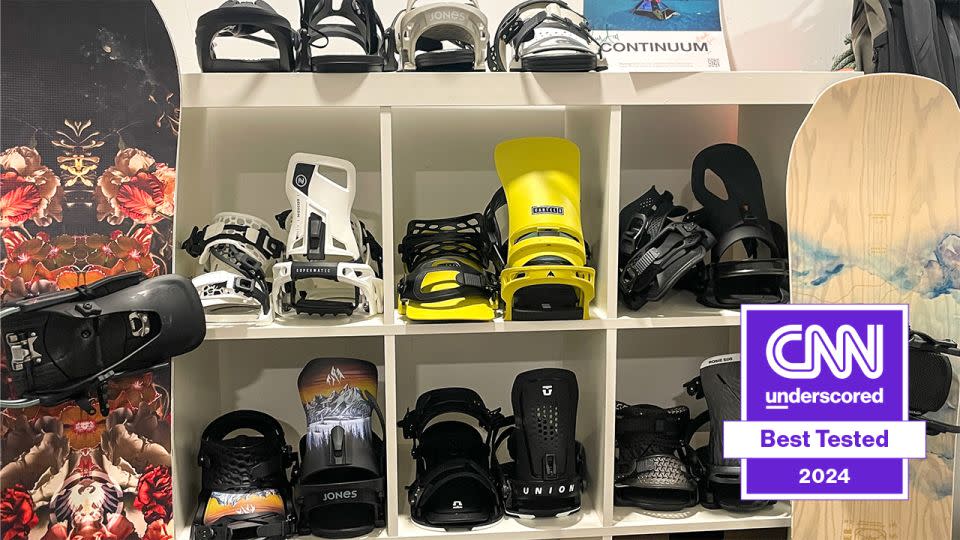
Snowboard bindings are an important part of your setup, as they’re your main connection to your snowboard. They can make you feel more stable or more playful, but finding the right one for your style can be tricky.
To find the best snowboard bindings of the season, we spent many laps carving, jumping and finding the powder as we tested 11 different sets. We considered factors like overall stiffness or flexibility, how many parts could be adjusted on the fly without tools and the quality of the parts and hardware. After numerous days spent on the mountain, three bindings ranked the best.
Burton Cartel X Re:Flex
Best men’s snowboard bindings
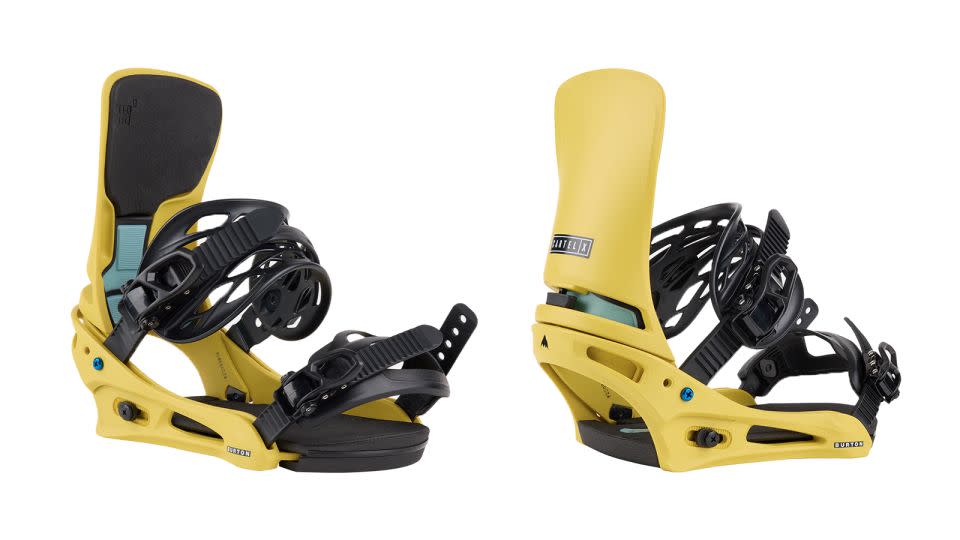
You really can’t go wrong with the Burton Cartel X Re:Flex, which are men’s bindings for riders who want a slightly more aggressive ride that still has a bit of playful flex. The Cartel X have a full cushion underfoot for a smooth ride, and you can adjust the highback easily when you want a more responsive ride.
Arbor Sequoia
Best women’s snowboard bindings
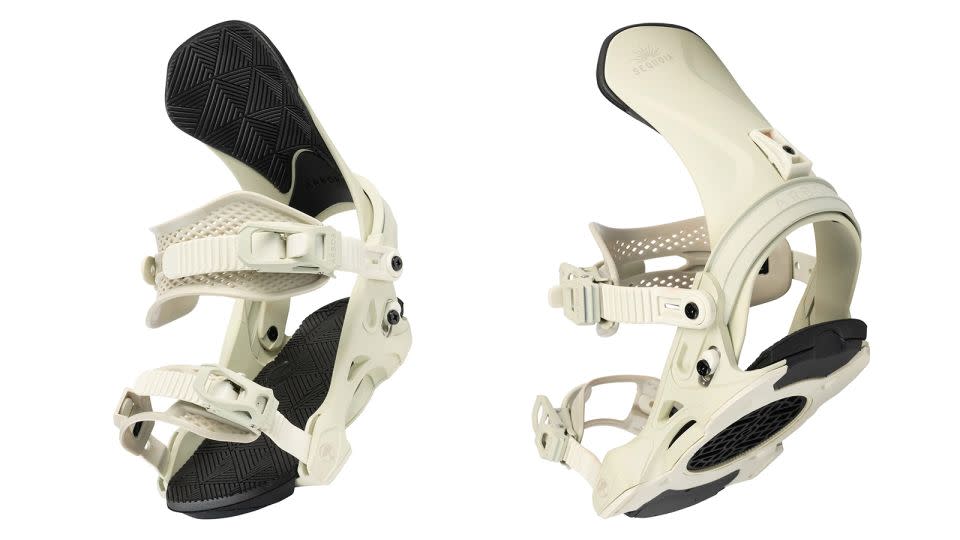
The Arbor Sequoia bindings are versatile, responsive and designed for women who ride all-mountain and want bindings that can keep up. The highback is asymmetrical for a more comfortable feel, and the heel cup is adjustable so you can get a super-secure, locked-in boot.
$200 at REI
$212 at Evo
$250 at Arbor
Burton Women’s Step On Re:Flex
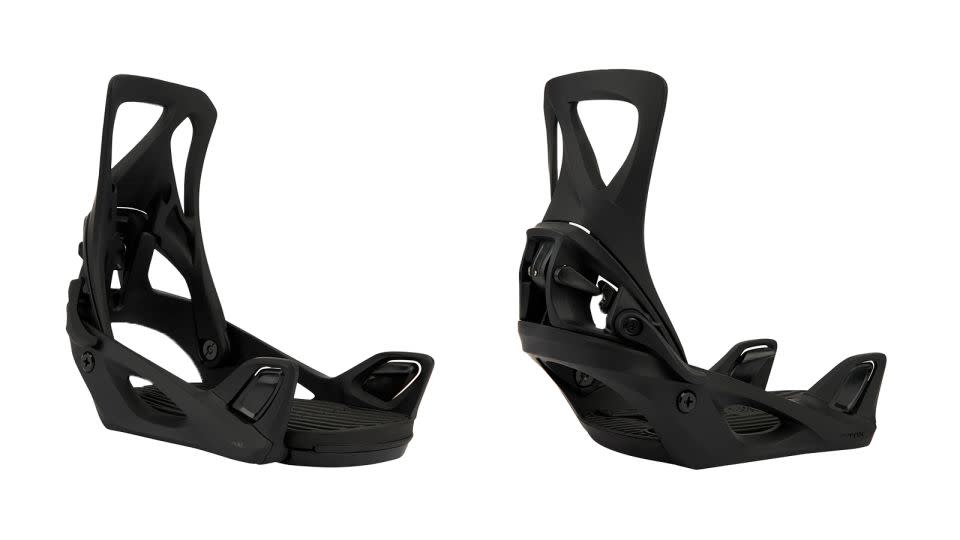
With the Burton Step On Re:Flex bindings, you don’t have to worry about lagging behind your skier friends or getting a cold butt every time you need to strap in. Instead, you can step, click and lock in with three anchor points for a smooth ride. Just be aware that these only work with Step On-compatible boots.
$300 at Burton
$300 at Backcountry
$300 at Amazon
Burton Men’s Step On Re:Flex
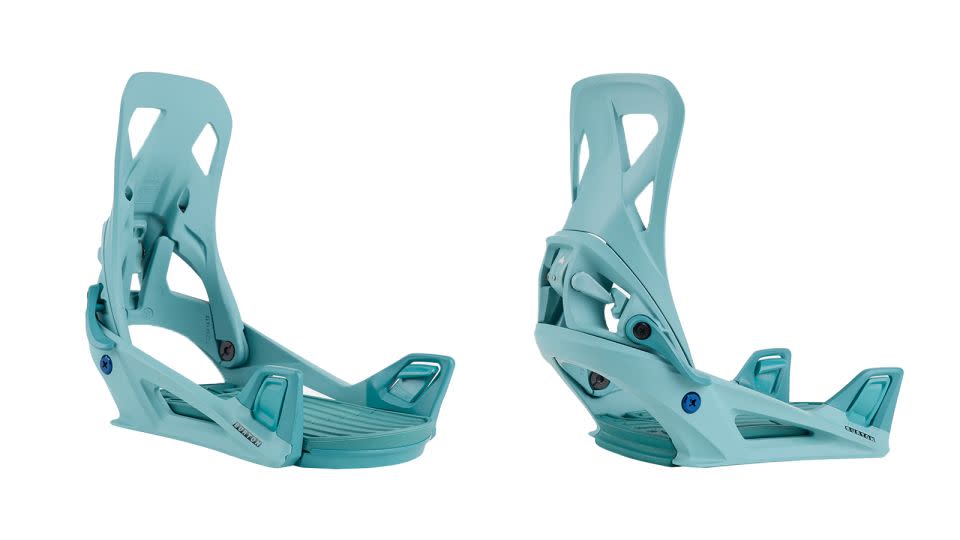
A men’s version of the Burton Step On bindings is also available with different sizing and slightly different looks.
$300 at Burton
$300 at Backcountry
$300 at Amazon
Best men’s snowboard bindings: Burton Cartel X Re:Flex
$330 at Burton and Evo
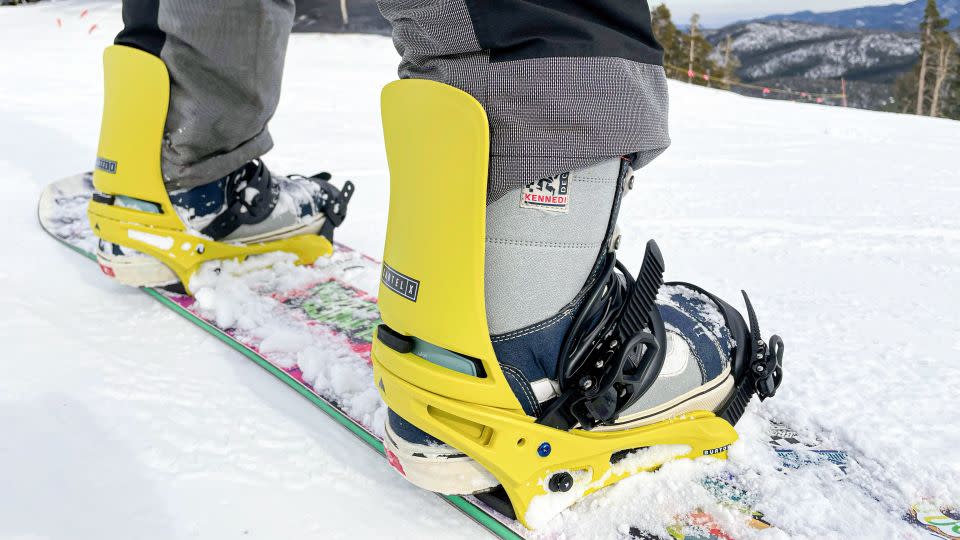
The Burton Cartel X Re:Flex were easily a top choice, as they were the most responsive men’s pair we tested. Even though these were some of the stiffest bindings we tried — which is perfect for intermediate to advanced riders who carve hard but less forgiving for beginners — they felt light when approaching and hitting jumps in the park, with a fun, playful feel. Their sweet spot is definitely on more dynamic terrain, but since not all the bindings we tested worked well both off-piste and in the park, the Cartel X bindings’ versatility was a big reason why they ranked so high.
For beginners or people who almost exclusively ride park, their stiffness might be a deterrent; however, this rigidity gives you impeccable responsiveness whenever you’re riding on steeper terrain. The highback (the part that supports the back of your calf) and the baseplate respond quickly to pressure, so when you try to turn, the Cartel X bindings immediately move with you and with full precision. We found that the stiffness also helped with overall support, compared to other bindings that had highbacks that were just too flexible. With the Cartel X bindings, we were supported on heelside turns and didn’t slip out at any speeds, unlike a few other options we tested, in which we felt much less support.
Other than feel and performance, the next most important thing you’ll want to pay attention to is the binding’s straps. Burton uses a buckle system that takes fewer cranks to adjust than most of the bindings we tested. The number of cranks and the time it takes to tighten traditional straps isn’t a huge differentiator, but we think it’s important to note the Cartel X bindings were quick and easy to tighten; we never ran into any problems securing our boots.
During testing, both straps stayed in place while riding and had a comfortable feel over the boots, which was not the case with all the bindings we tested. Toe straps are notorious for slipping off your boot, and while a few slipped off on others we tried, the straps on the Cartel X bindings never did, likely due to the grippy material and their toe-cap design. Both straps also have a bend to them that keeps them from flopping over the footbed, which makes it easier to get your boot in the binding because the straps aren’t in the way (similar to Jones binding straps and Union binding straps).
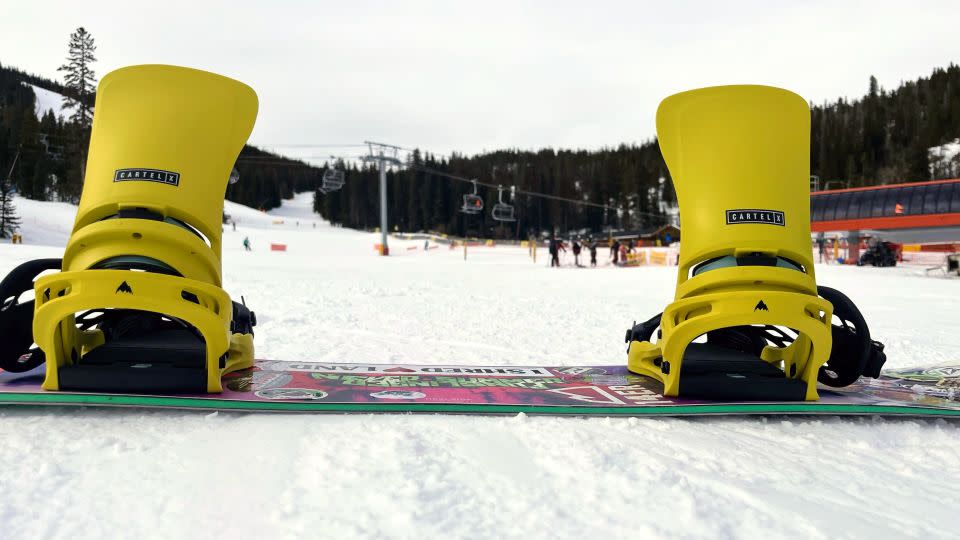
Mounting the bindings was easy, as was adjusting the straps, ladders and highbacks for the perfect fit. The straps did need a #3 Phillips screwdriver to adjust, but the highbacks and ladders could be changed on the mountain without any tools. This adjustability of straps, ladders and highbacks varies from binding to binding, with some having the ability to adjust both the ladders and highbacks without tools, sometimes just the highbacks and sometimes neither.
To adjust the highbacks on the Cartel X bindings, Burton uses a living hinge, which changes the angle with a small, rotating dial. This quick dial helped when we wanted more forward lean for better response on steeper runs, or less lean for a more forgiving feel when doing side hits and jumps. Most other bindings we tested had highbacks that could also be adjusted quickly, but this dial made the Cartel X bindings the easiest to adjust. Their ability to adjust on the mountain — for the most part without tools — really helps you fine-tune your fit day to day.
The men’s Burton Cartel X Re:Flex Bindings took us securely from the park to the trees and could be adjusted as we rode. The versatility and performance on varied terrain really pushed these bindings over the top, along with their quick responsiveness from edge to edge and an overall smooth board feel and ride. If you’re an intermediate to advanced rider looking to conquer the whole mountain, we think you’ll love the Burton Cartel X Re:Flex Bindings.
Best women’s snowboard bindings: Arbor Sequoia
$250 $200 at REI; $250 $212 at Evo; or $250 at Arbor
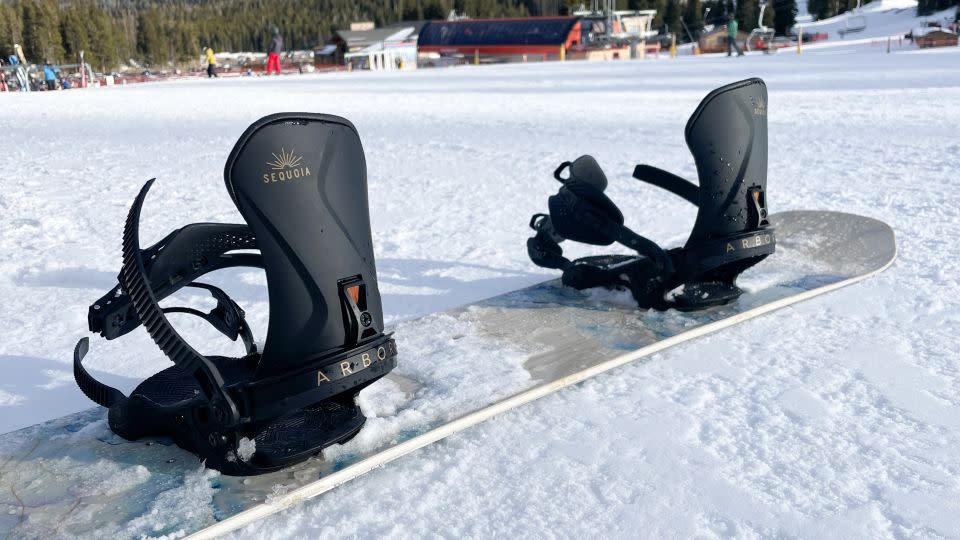
The Arbor Sequoia Women’s Bindings tested well in nearly all our tests. They rode with a responsive feel, they were easy to adjust and the vibe was playful without being too loose, thanks to their medium-stiff flex. Their all-around great performance and a few added features like an asymmetrical highback and an adjustable women’s-specific heel cup easily clinched the Sequoias a top spot. They tested well on flat groomers and steep slopes as well as in the moguls and the trees. They’re consistent and reliable all-mountain bindings, perfect for intermediate and advanced snowboarders.
The Sequoias have an overall stiffness that’s right in the middle of flexible and stiff. This translated into a responsive feel with quick and easy turn initiation, which meant no lag and buttery-smooth transitions from heelside to toeside on all types of terrain. Differences in transitions between the various bindings we tested were subtle but still noticeable. With the Sequoias, the board transitioned from edge to edge with the tiniest bit of movement from our lower body. Other bindings, like the Union Trilogy, were still quick, but the transition wasn’t nearly as smooth or immediate.
The highbacks of the Sequoias are asymmetrical, so they come up higher on the outside of your calves and lower toward the inside to get support right where you need it when carving hard. I didn’t notice a huge advantage to this design over other highbacks while riding, but the construction did feel very supportive overall, especially when turning onto my heelside where the outside of my front calf was slightly more locked in. When on my toeside, my back calf then pressed more into the larger part of the highbacks for additional support. While asymmetrical highbacks aren’t a deal breaker, they were just another small plus for the Sequoias that brought them over the top. Additionally, since they’re made for women, the highbacks are slightly shorter so that they don’t come too high up your boots.
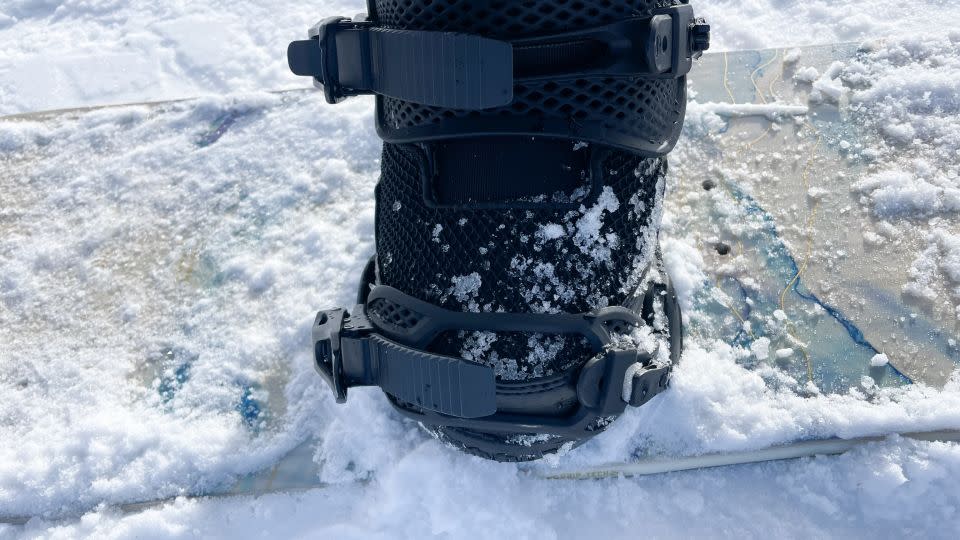
Another winning aspect of this binding is Arbor’s strap design, which, like the Burton Cartel X straps, is created with a curve to stay open and not flop in your way when stepping in with your boot. This simple design helped take away a lot of the frustration of getting ready to ride after the lift. Rather than having to kick the straps out of the way or step on them and bend them like I tend to do, both straps and ladders just stayed open above the base of the binding. I could easily and quickly get my foot into the binding without any obstacles. Others we tested that have this feature include the Jones Meteorite, the Jones Aurora and the Rome Katana, but the Arbor bindings were the most user-friendly as they didn’t flop too far over in either direction.
The straps on the Arbor Sequoias are easily adjustable too, and you don’t even need tools to get your perfect fit on the fly. With my usual bindings, the toe strap on my back foot often slips off my boot mid-run, but with the Sequoias, I was able to adjust the straps so they were angled perfectly. That minute change, plus a grippy strap that can be worn over my toe cap (rather than directly over my toes) made for a very smooth, reactive ride, especially on my heelside — without any strap slippage. Besides quick-and-easy strap adjustments, the highbacks and heel cups can also be changed, but you do need a tool. Adjusting the heel cups helps make sure your boots are flush with the back of the bindings; you can also adjust the heel cups on the Rome Katana and the Union Force. Unlike the Sequoias, most bindings we tested had a toolless adjustable highback, which is a nice feature for on-the-go tweaks.
For dependable bindings no matter what terrain you’re riding — groomers, ice or powder — the Arbor Sequoia will hold up. They provide comfort from the baseplate to the cushioned highback and respond quickly with each turn. The versatile, all-mountain bindings offer up that playful feeling when you want it but can charge hard when you are getting more aggressive on those black diamond runs.
Best fast-entry snowboard bindings: Burton Step On Re:Flex
Women’s: $300 at Burton, Backcountry and Amazon
Men’s: $300 at Burton, Backcountry and Amazon
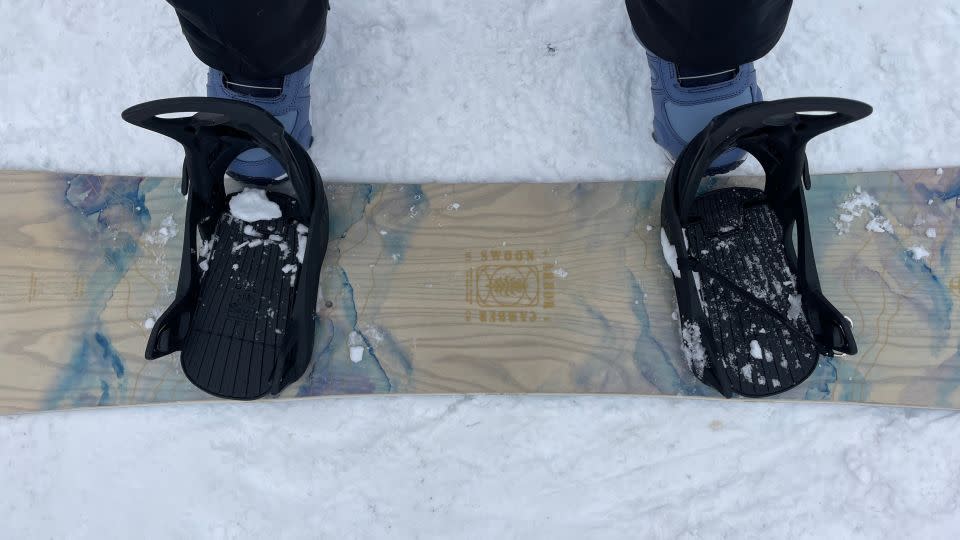
Burton came out with the Step On bindings in 2017 and truly changed the game for snowboarders who didn’t want to bend down or sit on the cold snow each time they had to strap in. After testing the women’s Burton Step On Re:Flex bindings, I can understand why all the snowboarders I’ve ever seen wearing Step On bindings in the lift lines rave about them. The Step On bindings don’t have straps; instead, they clip into specific, compatible boots. Even with this simple clip, the bindings still provide a secure ride that felt just as smooth and responsive as traditional strap bindings. Overall, Burton’s Step On bindings are by far the easiest bindings to get in and out of quickly — without needing to sit down.
The Burton Step On system uses three points to connect each boot to the board: a clip on either side of the toes and a clip at the heel. You simply snap your toes in first, then stomp down on your heel, no sitting or bending down required. Both parts clicked in seamlessly without much of a learning curve; the first few times, I did have to do an extra little stomp-jump to ensure that I was fully clicked in, but after a few runs, I felt confident with my first try. To get a boot out of the binding, you simply lift the lever on the outside of the binding, which will release your heel. This part had a slight learning curve, as you do have to lift the lever and your heel a little bit at the same time. Then you just maneuver your toes out of the clips with a bit of a wiggle and a slight turn (sort of like getting out of clip-in cycling shoes but not nearly as aggressive).
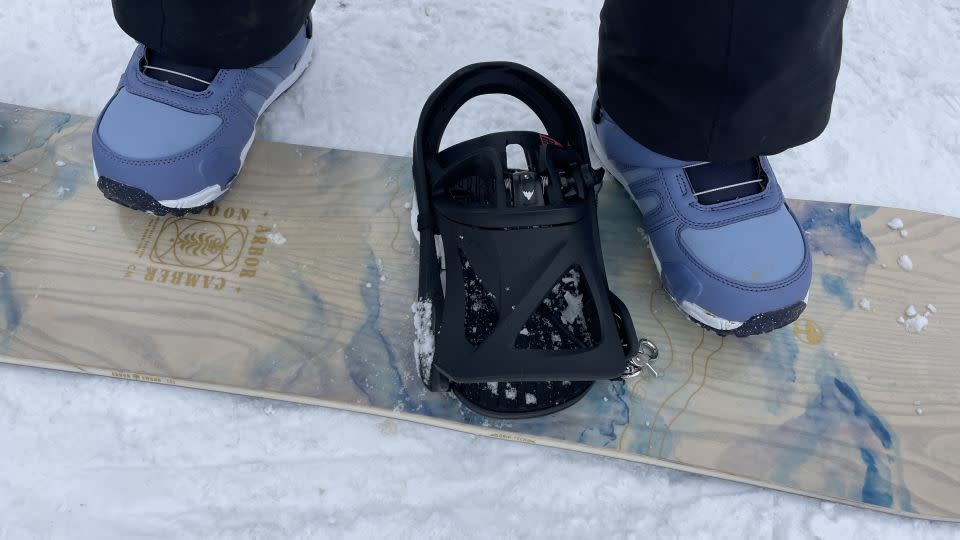
I can’t rave enough about how quick, easy and convenient this setup is. Once you do a few runs without plopping onto the cold snow after getting off the lift, I promise you’ll never want to go back. However, while this system is amazing, the big downside is that the Step On bindings are only compatible with a limited number of boots, which you can only get from Burton or DC.
Even though I didn’t have straps over my boots, I could not tell the difference when riding with these bindings compared to traditional ones with straps. Carving on groomers felt responsive with good board control, both at lower speeds and higher speeds. My heel felt super secure in the back clip with toeside turns, and the highback was supportive on heelside turns. I was pleasantly surprised to find that the Step On bindings provided quick feedback and efficient turning even when on moguls or cruising trees, but I do prefer traditional strap bindings when I’m really charging hard and making a lot of turns, mainly just for peace of mind but also for added stability. My toes feel more secure on this type of terrain in regular strap bindings, like with the Rome Katanas or the rear-entry Supermatics by Nidecker, which are also a nontraditional, fast-entry option.
The overall stiffness of the Step On bindings rests in the middle of flexible and stiff, so the’re quite versatile for whatever type of rider you are. My calves and feet felt supported when on my heel edge with the slightly stiff highbacks, which helped lessen fatigue in my feet and calves. And for general ride feel, the bindings felt stiff enough for good support through tight turns but still had a bit of playfulness if I was hopping around on groomers.
One downside of these bindings is that if I did need to adjust the highback for more support throughout the day, I had to use a tool, unlike most of the other highbacks we tested. Being able to adjust the highbacks easily is a nice feature since it can change with the type of riding you’re doing or what type of terrain you’re on; in the park, you’ll want your highbacks with a less aggressive forward lean so you have more freedom of movement, but with steeps, you’ll want a more aggressive forward lean for additional support and responsiveness.
However, because there aren’t straps, ladders or buckles, there is overall less to adjust and fine-tune. This can be seen as both good and bad: Having more parts that you can dial in means a more precise fit, but it also means more parts that can come loose or even break.
If you can’t (or just don’t want to) sit down or bend over every time you strap in, these should be your next bindings. Because you can only use the Step On bindings with Step On boots and vice versa, it’s a bit of an investment, as you’ll be locked into one rig that can’t work with other setups. But the compatible boots (by Burton and DC) are comfortable and supportive, and the whole system makes for a much quicker transition from chair to riding. And who doesn’t want that?
How to choose snowboard bindings
When choosing snowboard bindings, there are two main aspects to consider: the type of bindings you want and how much flex you prefer, which will depend on your skill level and where you are riding. Generally, flexible bindings are best for a newer rider or someone who most often rides park; stiffer bindings are better suited for riders who are more aggressive with their turns on steeper terrain.
There are three main types of bindings, each with its own benefits:
Straps: Bindings with a toe strap and ankle or heel strap are traditional and what you’ll see most often. A strap secures over the toe of your boot and then also on the top of your ankle to lock in your heel. Since the straps ratchet on and off, it takes time to strap in, and often, you have to sit down to get properly tightened.
Step-ins: Step-in bindings have been around for a while, but the newest iterations are much, much better than past ones. They have more support, are easier to use and ride basically the same as regular strapped bindings. The most common step-in bindings you’ll see on the slopes are Burton’s Step On Bindings, as well as the K2 Clicker system and Flux bindings. With step-in bindings, you don’t need to sit down to clip in or out, which is ideal for people with bad knees or who can’t get up off the ground as easily. Or for those who simply want to get off the chairs and into their bindings quicker.
Rear-entry: Rear- or speed-entry bindings have also been around since the mid-’90s, with one type being made by Flow Bindings and a similar one in the Nidecker Supermatic bindings (both of which are owned by the parent company Nidecker Group). These speed-entry bindings work by releasing the highbacks outward so that you can slip your boots in or out from the back. There are still straps on the ankles and heels to secure you into the bindings.
When buying snowboard bindings, it’s also important to consider how adjustable each part of the bindings are and if they can be adjusted without tools. To get a fine-tuned fit for your binding, you’ll want to adjust the straps, the ladders, the highbacks and, if possible, the heel cups. With most bindings, you’ll find that some of these elements can be adjusted without tools, like the highbacks and ladders, but that other parts will need tools to change the positioning. We like to prioritize toolless highbacks, since they make the biggest difference when riders want a different feel going over various terrain. Straps, ladders and heel cups don’t typically need to be adjusted on the fly as much.
You’ll also want to consider the types of straps on your bindings, especially the toe straps. I’ve found that one of my biggest gripes with various bindings is that the back toe straps slip off my toes. Check for straps that are listed as super grippy, and if they are designed to go over the top of your toes and boots or more on the toe caps of your boots. Straps that are designed for the toe caps of your boots, or are a hybrid of traditional toe straps and cap straps, can often lead to more secure straps with no slippage.
How we tested
To test the bindings with a comprehensive lens, I hit the mountain with two other snowboarders. For some of the men’s bindings, we had two riders help test fit and performance, both of whom come from Eldora Mountain in Colorado: Luna Springe, a tuner at Eldora who mostly rides steeps but also some park, and Michael Willson, a snowboard instructor and trainer who rides park and all-mountain. We got a few semi-decent powder days at resorts like Eldora, Copper Mountain Ski Resort, Keystone Ski Resort and Arapahoe Basin and on different boards like the Aura by Never Summer and the new Swoon Camber by Arbor.
For metrics, we looked at the stiffness of the base of the bindings and the highbacks, how easy it was to adjust various parts of the bindings and the overall quality of the hardware and straps. Here’s what we specifically looked for during our testing:
Stiffness and flex: We rode with each of the bindings for a full day or two on the mountain in varying conditions, including groomers, park, moguls, trees and powder, to get a good feel for their flex.
Fit and ease of use: We looked at how easy it was to get in and out of the bindings, like how quickly the ratchets worked or if the straps got in the way. We also took note of how well the toe straps stayed on our boots instead of slipping down when carving hard.
Adjustability: We noted which elements of the bindings were adjustable, how easy they were to change and whether you needed a tool.
Hardware: As we set up the bindings on our boards, we took notice of how well the ratchets or buckles worked and if the straps appeared durable or flimsy.
Other snowboard bindings we tested
Jones Meteorite Snowboard Bindings
$330 $280 at Jones Snowboards
If you’re an intermediate rider who wants bindings to match, the Meteorite bindings by Jones Snowboards are a good go-to. They’re a more flexible, softer binding (Jones lists them as having a medium-soft flex), which worked really well when we played around in the park. We found these had a bit of a surfy feel, but when riding, they still responded well when we needed them to, like on moguls and trees with more aggressive turns. These are a top, versatile choice for any all-mountain rider. The main reason these bindings didn’t earn a top spot was because of their more flexible nature, which does limit a secure ride for more advanced snowboarders.
Rome Katana Bindings
$400 $360 at Rome Snowboards
The Rome Katana bindings are overall solid bindings and could have been a top pick, but at $70 more than most of the other bindings we tested, there wasn’t enough there to justify the extra cost. They are very lightweight, are responsive and have one of the best toe straps we tested; it’s made with a cutout design in really flexible material so it stretches over and almost fuses to the toes of your boots. Overall, these all-mountain yet playful bindings are ideal if your toe straps often slip down, which can be both annoying and a bit dicey, but we think the Burton Cartel X bindings are the better pick for most.
Jones Women’s Aurora Bindings
$350 $297 at Jones Snowboards
These women’s bindings are brand new this season and new overall for Jones: They’re the brand’s first go at a women’s-specific binding. Though they didn’t clinch a top spot, they’re a very good choice for all-mountain riders who want a stiffer flex in less aggressive terrain. They offer a surfy ride due to the SkateTech construction, which makes it so they can pivot like a seesaw on the fulcrum of the bindings. That way, instead of pulling the bindings and the board as you turn with no give, you’re getting a more efficient and specific response from the bindings since the power is coming from the edges, not the middle of the baseplates. This helped deliver a smooth and efficient board-to-binding feel. Although these are very good, they’re on the more expensive end of what we tested and might be a bit too stiff for most.
Nidecker Supermatic Bindings
$400 at Nidecker
The Supermatic speed-entry or rear-entry bindings by Nidecker came in such a close second behind the Burton Step On bindings. They were easy to use and understand, you can use whatever boot you want (unlike the Burtons or the K2 Clickers), but we found the stability to be just slightly lacking. When fully clicked in, we felt like our back heel was rising out of the binding a small amount on each hard, toeside turn. It was hard to tell if this was actually happening, as we could definitely tell that the system was locked into place, but there was just a slight give that made for some anxiety when really carving hard. That, along with the fact they cost $100 more than the Burton Step On bindings, kept them out of the running.
Union Force Men’s Bindings
$330 at Union Binding Company
If you want bindings that can perform as well on steep slopes as on groomers, check out the men’s Force bindings by Union Binding Company. The Force ride smooth and responsive and are made for all-mountain riding with a stiffer flex. While they had a smooth and responsive ride, the back toe strap slipped off every once in a while, which made for uneasy turns.
K2 Clicker Bindings
$280 at K2
The K2 Clicker bindings are another step-in binding option, which also requires a specific boot to use. Getting in and out of these was not nearly as smooth or easy as with the Burton Step On bindings, which is the biggest reason they didn’t claim a top spot. I was never able to actually get in or out while standing up — the main point of step-in bindings — but maybe that was just me. The biggest draw we see with these bindings is the boots that are compatible with them. While the Burton Step On boots are only compatible with Step On bindings, the Clicker boots can be used with traditional bindings too. So if you’re switching bindings and don’t want to fully commit to a step-in style, these could be a good pick for you.
Union Women’s Trilogy Bindings
$280 $210 at Union Binding Company
The women’s Trilogy bindings by Union Binding Company are an all-around good binding for riders who do a little bit of everything — on-piste, off-piste and even park. Union lists these bindings as right between flexible and stiff, but I found them to be more flexible with a bit less response than some of the other bindings we tested. These are a good choice for intermediate riders who want some playfulness. The straps and the highbacks are, however, easy to adjust without tools if you want a tighter fit or a more aggressive lean. Overall, the Trilogy bindings are a bit more sluggish when it comes to responsive turns than other bindings we rode but are a solid choice if you like a middle ground of flexibility and stiffness.
Arbor Cypress Bindings
$300 $180 at Arbor Collective
Overall, the bindings were great mid-speed cruiser bindings and felt great through jumps and moguls that weren’t steep, but they fell very short when it came to any terrain beyond that of an easy black. They were very easy to adjust on the go; however, the flexible highbacks were just too soft to feel secure on steep runs or ice, and they quickly led to foot and calf fatigue. Opt for these bindings if you ride park often, but they’re not great if you’re charging blacks.
Note: The prices above reflect the retailers' listed price at the time of publication.
For more CNN news and newsletters create an account at CNN.com

